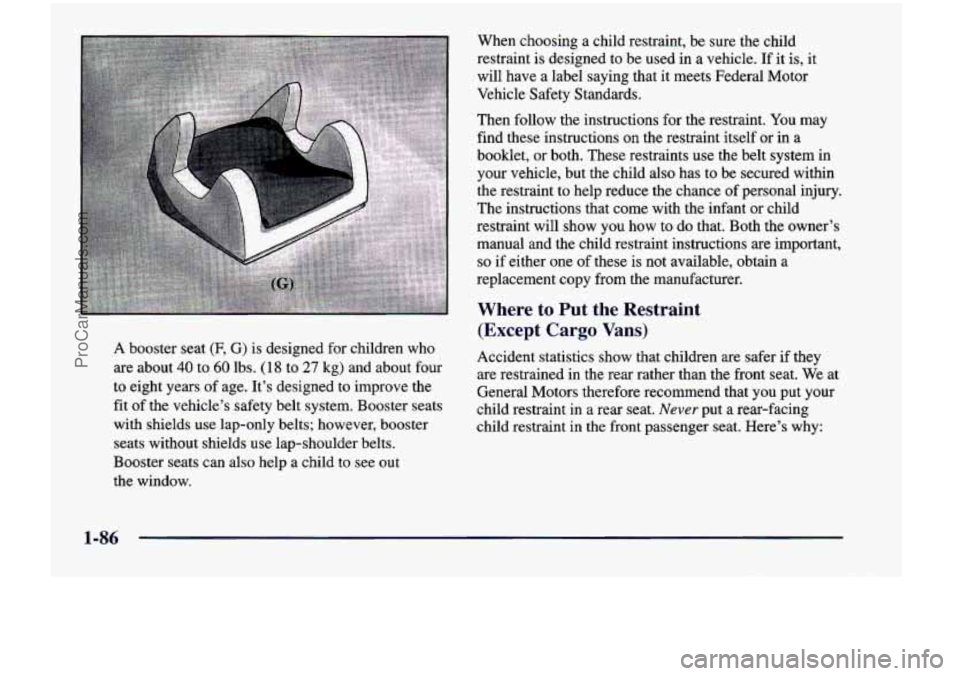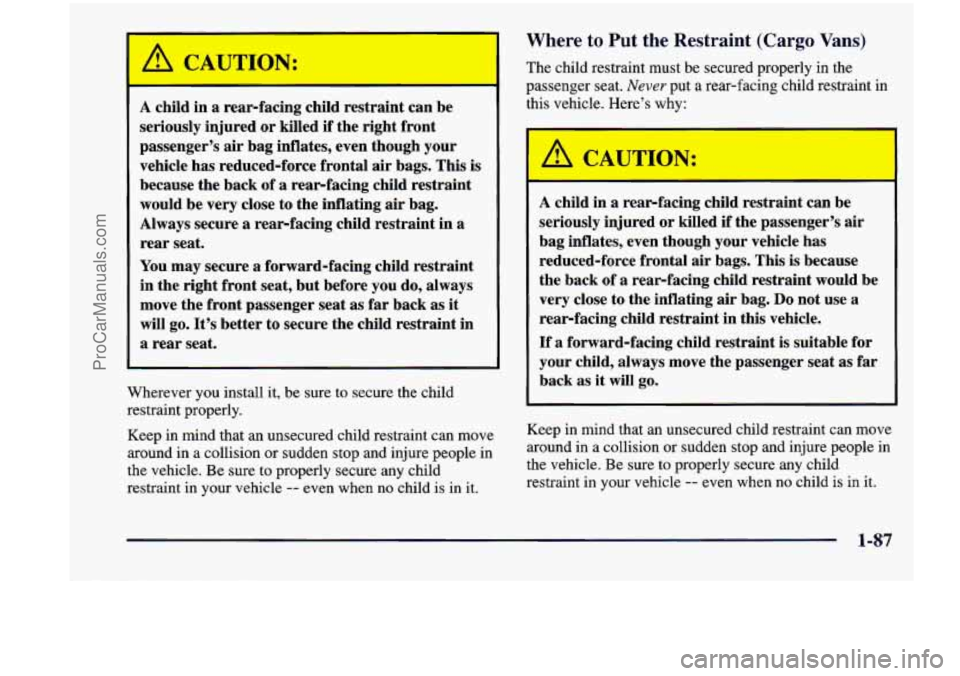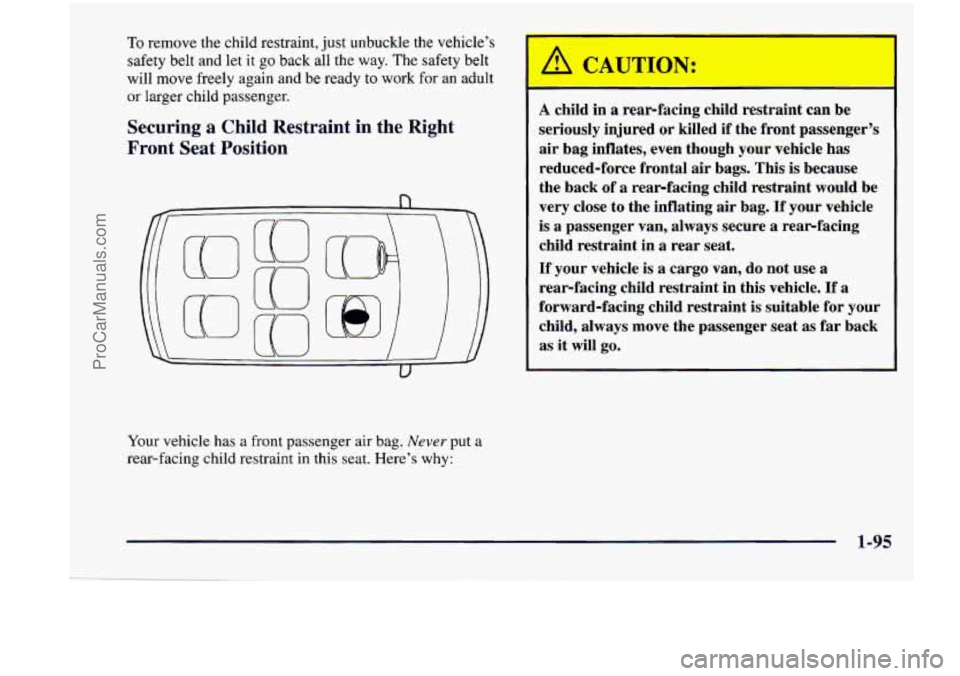Page 99 of 474

When choosing a child restraint, be sure the child
restraint is designed to be used in
a vehicle. If it is, it
will have a label saying that it meets Federal Motor
Vehicle Safety Standards.
Then follow the instructions for the restraint.
You may
find these instructions on the restraint itself or in a
booklet,
or both. These restraints use the belt system in
your vehicle, but
the child also has to be secured within
the restraint to help reduce the chance of personal injury.
The instructions that come with the infant or child
restraint will show you how to do that. Both the owner's
manual and the child restraint instructions are important,
so if either one of these is not available, obtain a
replacement copy from the manufacturer.
Where to Put the Restraint (Except Cargo Vans)
A booster seat (F, G, is designed for who Accident statistics show that children me safer if they
are about 40 to 6o lbs* (18 to 27 kg) and about four are restrained in the rear rather than the front seat. We at
to eight years of age. It's designed to improve the
General Motors therefore recommend that you put your
with shields use lap-only belts; however, booster child restraint
in the front passenger seat. Here's why:
seats without shields use lap-shoulder belts.
Booster seats
can also help a child to see out
the window.
fit
Of the
vehicle's safety belt system. Booster seats child restraint in a rear seat. Never put a rear-facing
1-86
ProCarManuals.com
Page 100 of 474

A child in a rear-facing child restraint can be
seriously injured
or killed if the right front
passenger’s air bag inflates, even though your
vehicle has reduced-force frontal air bags. This is
because the back of
a rear-facing child restraint
would be very close to the inflating air bag.
Always secure
a rear-facing child restraint in a
rear seat.
You may secure a forward-facing child restraint
in the right front seat, but before you do, always
move the front passenger seat as far back as it
will go. It’s better to secure the child restraint in
a rear seat.
Wherever you install it, be sure to secure the child
restraint properly.
Keep in mind that an unsecured child restraint can move
around in a collision or sudden stop and injure people in
the vehicle. Be sure to properly secure
any child
restraint in your vehicle
-- even when no child is in it.
Where to Put the Restraint (Cargo Vans)
The child restraint must be secured properly in the
passenger seat.
Never put a rear-facing child restraint in
this vehicle. Here’s why:
A child in a rearfacing child restraint can be
seriously injured or killed if the passenger’s air
bag inflates, even though your vehicle has
reduced-force frontal air bags. This is because
the back of a rear-facing child restraint would be
very close to the inflating air bag.
Do not use a
rear-facing child restraint in this vehicle.
If a forward-facing child restraint is suitable for
your child, always move the passenger seat as far
back as it will go.
Keep in mind that an unsecured child restraint can move
around in a collision or sudden stop and injure people in
the vehicle. Be sure to properly secure any child
restraint in
your vehicle -- even when no child is in it.
1-87
ProCarManuals.com
Page 101 of 474
Top Strap
There's a vinyl sleeve there; to get to the bracket, push this
vinyl sleeve aside slightly. You may need to remove the
staple
in the sleeve to do this. Anchor the top strap to the
bracket.
If your vehicle does not have third row seats and
If your child restraint has a top strap,
it should be
anchored. A child restraint with a top should only belts, or if you need to have an anchor bracket installed for
be used in the second row. If your vehicle has third row the center bucket seat in the second row, or for the right-ha\
nd
seats, anchor brackets for the second row outside
side
of a 60140 bench seat, you can ask your Chevrolet dealer
positions are located just above the place where the third
to put it in for you. you want to install an anchor bracket
row lap-shoulder belts meet the floor.
yourself, your dealer can tell you how to do it.
Once you have the top strap anchored, you'll be ready to
secure the child restraint itself.
ProCarManuals.com
Page 102 of 474
Securing a Child Restraint in a Rear
Outside Seat Position You’ll be using the lap-shoulder belt. See the earlier part
about the top strap if the child restraint has one. Be sure
to follow the instructions that came with the child
restraint. Secure the child in the child restraint when and
as the instructions say.
1. Put the restraint on the seat.
2. Pick up the latch plate, and run the lap and shoulder
portions
of the vehicle’s safety belt through or
around the restraint. The child restraint instructions
will show you how.
If the shoulder belt goes in front of the child’s face or
neck, put
it behind the child restraint.
1-89
ProCarManuals.com
Page 104 of 474
5.
6.
To tighten the belt, feed the shoulder belt back into
the retractor while you push down on the child
restraint. If you’re using a forward-facing child
restraint, you may find it helpful to use your knee to
push down on the child restraint as you tighten
the belt.
Push
and pull the child restraint in different
directions to be sure it is secure. To
remove the child restraint, just unbuckle the vehicle’s
safety belt and let
it go back all the way. The safety belt
will move freely again
and be ready to work for an adult
or larger child passenger.
Securing a Child Restraint in the Center Seat Position (Third
Row Bench Seat)
n
You’ll be using the lap belt. Be sure to follow the
instructions that came with the child restraint. Secure
the child in the child restraint when and as the
instructions say.
1-91
ProCarManuals.com
Page 106 of 474
6. Push and pull the child restraint in different
directions
to be sure it is secure.
To remove the child restraint, just unbuckle the vehicle’s
safety belt. It will be ready to work
for an adult or larger
child passenger.
Securing a Child Restraint in the Center
Seat Position (Bucket
Seat)
You’ll be using the lap belt. See the earlier part about
the top strap
if the child restraint has one. Be sure to
follow the instructions that came with the child restraint. Secure
the child in the child restraint when and as the
instructions
say.
1. Put the restraint on the seat.
2. Pull the lap belt all the way out without stopping.
3. While holding it out, run the belt through or around
the child restraint. The child restraint instructions
will show you how.
ProCarManuals.com
Page 107 of 474
4. Buckle the belt. Make sure the release button is
positioned
so you would be able to unbuckle the
safety belt quickly if you ever had to.
5. To tighten the belt, feed it back into the retractor
while you push down on the child restraint.
If you’re
using a forward-facing child restraint, you may find
it helpful to use your knee to push down on
the child
restraint as you tighten the belt.
directions to be sure
it is secure.
6. Push and pull the child restraint in different
1-94
ProCarManuals.com
Page 108 of 474

To remove the child restraint, just unbuckle the vehicle’s
safety belt and let it
go back all the way. The safety belt
will
move freely again and be ready to work for an adult
or larger child passenger.
Securing a Child Restraint in the Right
Front Seat Position
Your vehicle has a front passenger air bag. Never put a
rear-facing child restraint in this seat. Here’s why:
I
A child in a rearfacing child restraint can be
seriously injured or killed
if the front passenger’s
air bag inflates, even though your vehicle has
reduced-force frontal air bags. This is because
the back of a rear-facing child restraint would be
very close to the inflating air bag.
If your vehicle
is a passenger van, always secure a rearfacing
child restraint in
a rear seat.
If your vehicle is a cargo van, do not use a
rear-facing child restraint in this vehicle. If a
forward-facing child restraint is suitable for your
child, always move the passenger seat
as far back
as it will go.
1-95
ProCarManuals.com